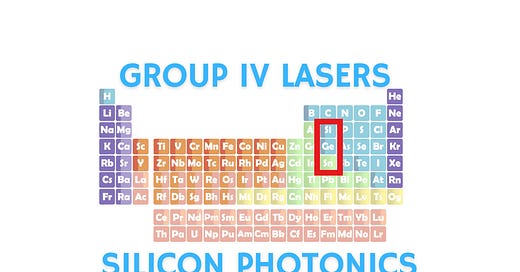The Silicon Photonics Moonshot: Group IV Integrated Lasers
An exploration of how group IV materials could solve the longstanding problem of silicon’s indirect bandgap, enabling monolithic photonic circuits with competitive laser performance.
Welcome to a 🔒 subscriber-only edition 🔒 of my weekly newsletter. Each week, I help readers learn about semiconductors, and stay up-to-date on complex topics.
Paid subscribers get access to the full post archive, extra learning resources and in-depth tutorials.
You can email me at substack@vsekar.com with topic suggestions, feedback or just about anything else. Connect with me on social media (X, LinkedIn, Bluesky), where I post a lot of content I come across in my article research. Join me on Substack chat for weekly discussion topics.
Silicon's high refractive index makes it an excellent material for photonic circuit construction. This means that complex components can be created in a small area. Furthermore, these photonic circuits can be manufactured on a regular CMOS line, leveraging the size and cost advantages of foundry fabrication. The main issue is that we can't create lasers directly on silicon due to its indirect bandgap.
In direct bandgap materials that involve III-V compounds like gallium arsenide (GaAs), electrons can directly emit photons when dropping from the conduction band to the valence band, making them ideal for lasers. In indirect bandgap materials from Group IV of the periodic table like silicon, germanium or tin, this transition requires a phonon (a lattice vibration) to conserve momentum, which makes photon emission far less likely and laser action inefficient. The crystal structure of group IV elements is compatible with silicon, and hence group IV lasers are highly suitable for low-cost, integrated photonics — if they work as well as III-V lasers, which they don’t.
Group IV lasers represent the moonshot, the Hail Mary of integrated light sources because they would eliminate the need for hybrid III-V laser integration, lowering costs and enabling mass produced photonic chips which could be a game changer for data centers, sensors, and consumer devices.
In this post, we will look at the research progress on Group IV lasers, and develop an understanding of how they can be used to build lasers.
🔒 Silicon Raman Lasers
🔒 Ge-on-Si Lasers
🔒 GeSn Lasers
🔒 Coda
🔒 References
Read time: 9 min
P.S.: There are a lot of semiconductor physics concepts in this post. If you need a brief introduction, the ongoing series I’m working on below should help.





